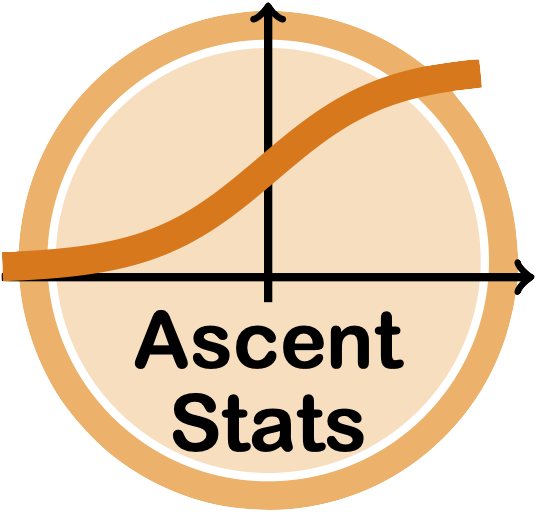Converting Bradley-Terry model parameters to Elo ratings
In the Bradley-Terry model, each item (e.g., a climber, or a climbing route) has a “strength” parameter, λ. We can use these strength parameters to compute the probability of one item “winning” over another:
\[\Pr(i \text{ beats } j) = \frac{\lambda_i}{\lambda_i + \lambda_j}\]In climbing competitions, the climber’s “strength” represents their climbing skill, whereas the route’s “strength” represents its difficulty. A climber wins by climbing the route within the time limit. The route wins if the climber fails.
We can convert these strength parameters to Elo ratings, a popular rating system used in games like chess. Now, let’s denote the Elo rating for item i as $E_i$. We want to find a relationship between $E_i$ and $\text{ln}(\lambda_i)$ such that a difference of 400 Elo corresponds to an increase in odds ratio of 10:1. To derive the relationship between Elo ratings and the strength parameters from the Bradley-Terry model, we first write:
\[\frac{\lambda_i}{\lambda_j} = 10^{(E_i - E_j) / 400}\]Taking the natural logarithm of both sides, we get:
\[\text{ln}\left(\frac{\lambda_i}{\lambda_j}\right) = \frac{E_i - E_j}{400} \times \text{ln}(10)\]Now, we can see that the difference in Elo ratings is proportional to the difference in the natural logarithm of the strength parameters:
\[E_i - E_j = 400 \times \frac{\text{ln}(\lambda_i) - \text{ln}(\lambda_j)}{\text{ln}(10)}\]To convert $\text{ln}(\lambda_i)$ to an Elo rating, we can use an arbitrary constant K as a baseline Elo rating:
\[E_i = 400 \times \frac{\text{ln}(\lambda_i)}{\text{ln}(10)} + K\]By choosing an appropriate value for K, you can center the Elo ratings around a desired value (e.g., 2000 for average IFSC competitor).
In summary, to convert the strength parameters from the Bradley-Terry model into Elo ratings, you can use this simple linear transformation:
\[E_i = \frac{400}{\text{ln}(10)} \times \text{ln}(\lambda_i) + K\]Where $E_i$ is the Elo rating for item i, $\lambda_i$ is the strength parameter from the Bradley-Terry model, $400/\text{ln}(10)$ is the standard elo scale factor and K is an arbitrary constant representing the baseline Elo rating.
 AscentStats
AscentStats